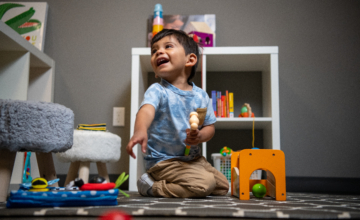Definition: Ensuring that young children and their families are connected to services that match their identified interests and needs. This involves identification of families in need of additional supports, screening and further assessment as needed to understand children’s developmental status and identify potential delays, referral and follow-up to ensure linkages to needed services, and efforts to support families if they are unable to receive additional services due to eligibility requirements or capacity issues.
IN THIS RESOURCE
- STRATEGIES
- Oklahoma
- New Jersey
- Georgia
- Confederated Salish and Kootenai Tribes
- Pueblo of San Felipe
- New York
- West Virginia
- Washington
- Illinois
- Survey of Well-Being of Young Children in Tribal Communities
- Connecticut
STRATEGIES
- Use centralized intake to connect families to services that match their needs
- Use common forms (applications, screening tools, referral forms) and data systems across programs and services
- Expand developmental screening across all settings serving young children
- Establish a centralized telephone access point to connect children and their families to needed services
- Develop community hubs to deliver multiple services to families in a single location
Oklahoma
Oklahoma supports community connectors at the local level to promote home visiting, facilitate cooperation between home visiting and other programs, and assist families in accessing home visiting and other needed services.
- Oklahoma’s two most populated counties—which include 2/3 of the state’s citizens, Tulsa and Oklahoma Counties—are receiving MIECHV (Maternal, Infant and Early Childhood Home Visiting) funds to hire community connectors to link families with needed services.
- Parent PRO promotes the home visiting system by directing families to community connectors to access home visiting services.
New Jersey
In New Jersey’s regional central intake system, providers use uniform referral and screening forms to link families to community supports, including the most appropriate home visiting program.
- Six regions designated central intake agencies. All 21 counties are covered.
- The central intake system started by connecting families to home visiting programs but has now expanded to include a variety of community-based services.
- Regional agencies use a standardized risk assessment and enter data into the Single Point of Entry for Client Tracking management information system.
Georgia
Georgia uses a central intake system and a standardized screening tool to determine eligibility for services.
- Beginning October 2012, Georgia implemented central intake with a statewide toll-free number, database for online referrals, and automatic screening of birth certificates.
- A standardized screening tool is used.
- The database is used to input information about families and to make and monitor referrals.
- Families are referred to home visiting programs as well as an array of other services.
Confederated Salish and Kootenai Tribes
Confederated Salish and Kootenai Tribes (CSKT) created joint training opportunities across TELI (Tribal Early Learning Initiative) partners around the Ages and Stages Questionnaire and the Developmental Indicators for the Assessment of Learning
- They have concentrated on creating joint professional development opportunities for providers, as well as holding community events focused on building parenting skills of parents with young children.
- Because the programs developed better understanding of each other’s services, the quality and timeliness of referrals has also improved. Programs are more willing and interested in sharing resources with each other.
Pueblo of San Felipe
Pueblo of San Felipe developed a Child Passport to use across all programs in an effort to streamline services for families, offer more timely referrals, and ensure continuity of care.
- The tribe recently purchased the child passport system and is expecting that programs will become more united in efforts to streamline all services.
- The intention is for all early childhood programs to use this as an education tool for families and to create a universal approach to health service information. They are hoping that all San Felipe families will learn the importance of children’s health records, immunizations, and well-child appointments, and that programs will know where to appropriately route referrals when families are in need of supplemental services.
New York
New York created a public health toolkit to help medical providers refer families to home visiting programs.
- Providers were trained on use of the toolkit through a webinar.
West Virginia
West Virginia developed a recruitment guide and slide presentation on home visiting for referral sources.
- West Virginia also has a Help Me Grow system and uses a centralized intake toll-free number.
Washington
Washington is exploring using Help Me Grow to assist Temporary Assistance for Needy Families in referring families to home visiting and early intervention as a pilot in one county.
- Statewide Help Me Grow (HMG) uses a phone line for central intake. The organization that operates HMG also does Women, Infants and Children intake, outreach for early intervention, and food assistance.
- Washington is exploring regional implementation of HMG.
Illinois
Illinois is initiating a universal newborn support system pilot in one or two communities that will offer all families a home visit when a child is born and refer families to additional services and supports as needed.
- A universal home visit will be used to assess families’ supports and needs so they can be referred to other services (including intensive home visiting).
Survey of Well-Being of Young Children in Tribal Communities
Seven tribal communities participated with the University of Colorado in the study and implementation of a social-emotional and developmental screening tool (Survey of Well-Being of Young Children or SWYC) specific to the needs and cultural contexts of children in tribal communities.
- This study examined the feasibility of the SWYC, a new screening tool for socioemotional and developmental problems and family risk in children birth to 5 years old, for use in American Indian and Alaska Native communities.
- A Community of Learning within the Tribal Early Childhood Research Center, composed of university researchers, tribal early childhood program staff and evaluators, and federal partners, used a community-based participatory research approach to guide this qualitative study. Thirty-two focus groups and 20 key informant interviews were conducted with staff from Head Start, home visiting, and child care programs; pediatricians; behavioral health providers; parents of young children; tribal leaders; and other stakeholders in seven diverse American Indian and Alaska Native communities.
- Three themes emerged: a) a strong need to screen early for social-emotional and developmental problems and family risk, b) the importance of a carefully designed process for screening, and c) the importance of examining the content of the SWYC for cultural fit specific to tribal communities.
- Findings support two recommendations: a) the development of guidelines for using the SWYC in tribal early childhood settings and b) a full-scale validation study to determine appropriate use with and norms for children in tribal communities.
Connecticut
Connecticut expanded the existing Child Development Infoline to add resources for pregnant women and new parents.
- The Child Development Infoline is a specialized call center of the 211 system and an access point for Help Me Grow.
- MIECHV also helped develop materials and market to the target audience.




